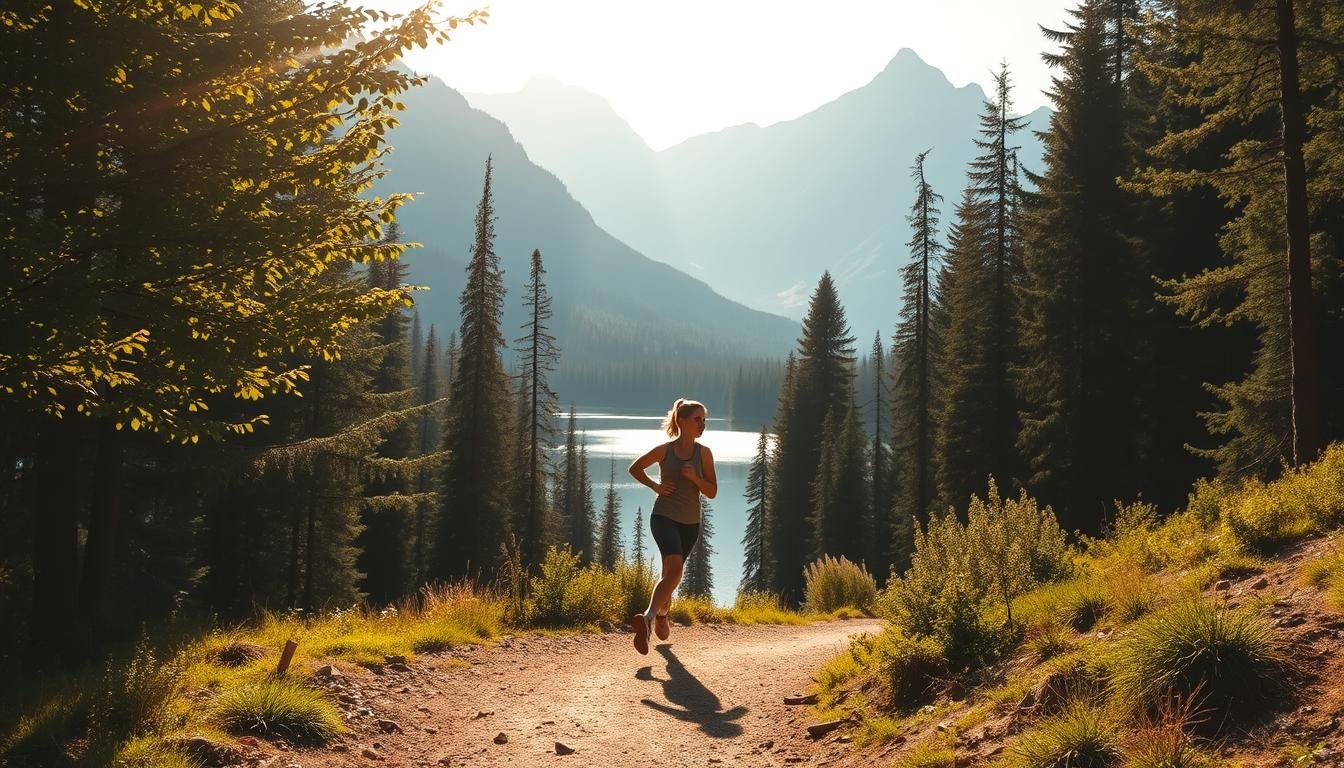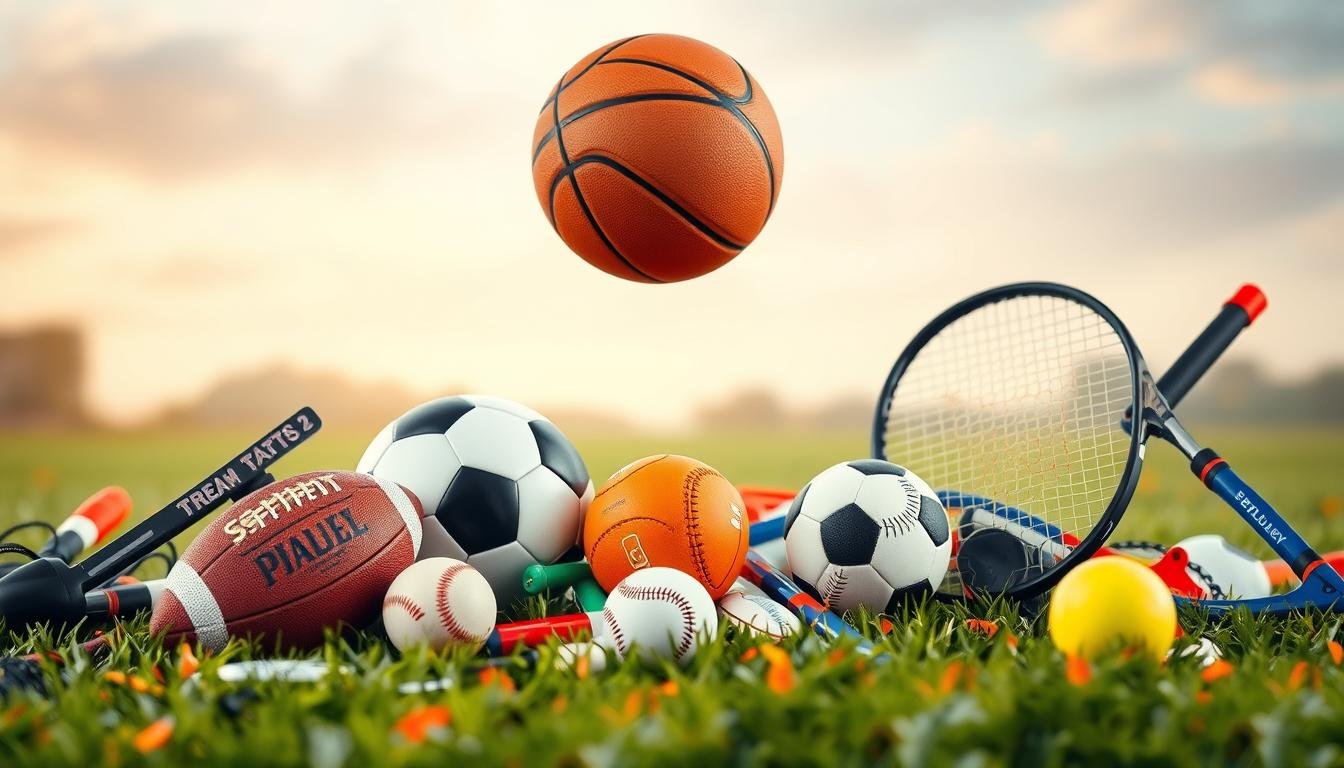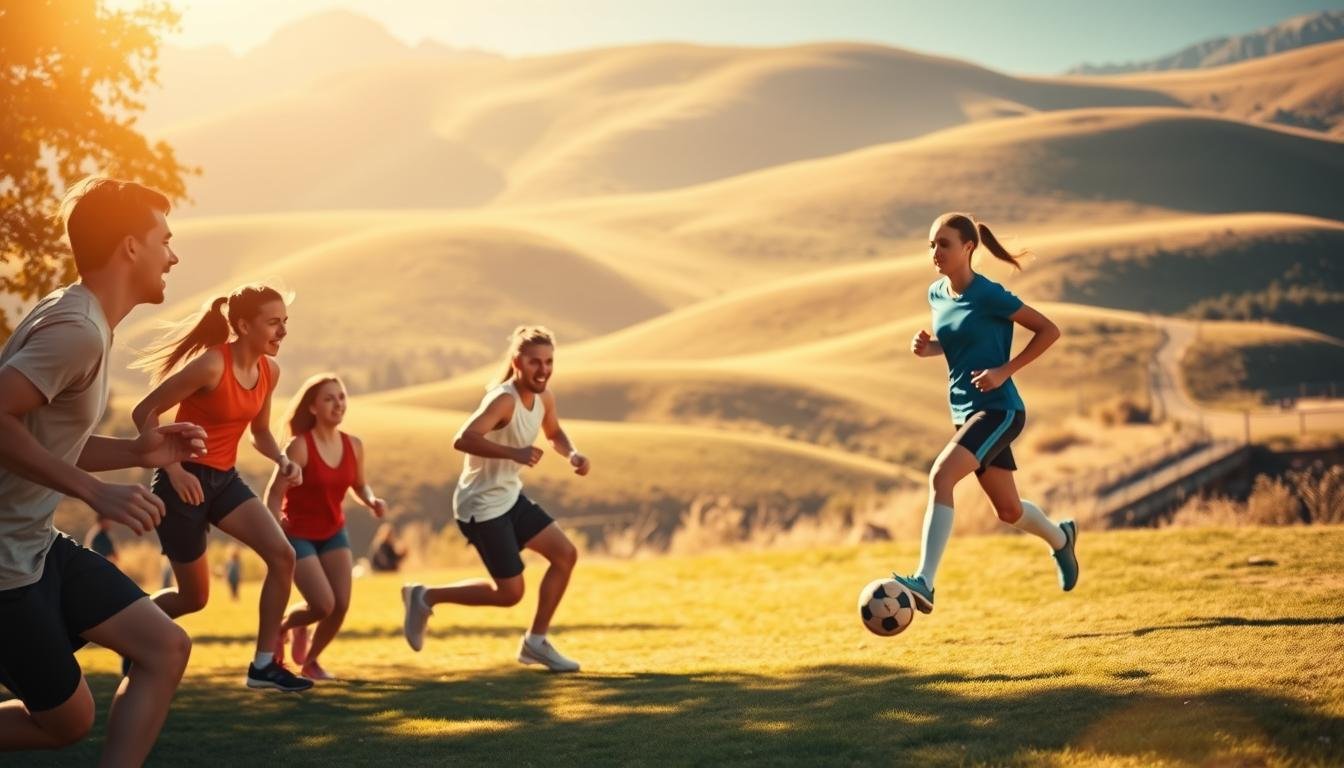Now Reading: One-Person Sports: Unleash Your Solo Adventure
-
01
One-Person Sports: Unleash Your Solo Adventure
One-Person Sports: Unleash Your Solo Adventure

One-Person Sports: Unleash Your Solo Adventure
Did you know that doing solo athletic activities can really help your mind and body? You get to pick when and where to work out. This is just one cool thing about individual sports.
Choosing one-person sports lets you set your own goals. You can run, swim, or cycle at your own speed. It’s a great way to get better and grow as a person.

Doing solo athletic activities makes you feel proud of yourself. It also makes you more confident. This can make you feel better in all parts of your life.
Key Takeaways
- Improved mental health through solo exercise
- Flexibility in scheduling workouts
- Personal growth through self-set goals
- Enhanced self-confidence
- Opportunities for self-improvement
The Rising Popularity of Solo Athletic Pursuits
Independent athletics are becoming more popular, attracting many different people. This trend is not just a short-term thing. It’s a big change in how we see fitness and sports.
Why Independent Sports Are Trending
Solo sports are appealing because they are flexible and offer a personal challenge. You can do them whenever you want, making it easy to stay active even when life gets busy.
| Benefits | Description |
|---|---|
| Flexibility | Exercise at any time that suits you |
| Personal Challenge | Set and achieve personal goals without external pressures |
| Convenience | No need to rely on others for scheduling |
The Freedom of Self-Paced Athletic Activities
Self-paced sports let you move at your own pace. This makes your fitness journey more personal. This freedom is a big reason why solo sports are getting more popular.
As more people enjoy the perks of solitary sports, this trend is likely to keep growing. It opens up many chances for people to take part in independent athletics.
Benefits of Engaging in One-Person Sports
One-person sports can change your life for the better. They boost both your physical and mental health. More people are finding joy in solo sports, improving their lives.
Physical Advantages
One of the main perks of solo sports is better physical health. Doing sports alone can make your heart stronger and muscles more powerful.
Improved Cardiovascular Health
Running, cycling, or swimming alone can greatly improve your heart health. It makes your heart work better and blood flow more. This lowers the risk of heart problems.
Enhanced Strength and Endurance
Solo sports also boost muscle strength and endurance. Weightlifting builds muscle, while long-distance running or cycling increases stamina.
Mental and Emotional Benefits
Solo sports do more than just make you fit. They also help your mind and emotions. They can make you feel less stressed and more focused.
Stress Reduction and Mindfulness
Doing solo sports can be a great way to reduce stress and find mindfulness. These activities help you focus and calm your mind.
Building Self-Reliance
Solo sports also help you become more self-reliant. They teach you to motivate yourself and grow personally. This builds your confidence and independence.
Flexibility and Convenience Factors
Solo sports are also flexible and easy to fit into your life. You can choose when and where to do them. This makes them perfect for busy schedules.
- Flexibility in scheduling
- Ability to train at any time
- No need to coordinate with others
Essential Equipment for Solo Sports Enthusiasts
Starting a solo athletic journey needs the right gear for safety and effectiveness. For those into individual sports, the first step can seem big. But, it’s key for both performance and fun.
Basic Gear for Beginners
Beginners in one-person sports should get basic, durable gear. A good water bottle is a must for staying hydrated in many solo activities.
Sport-Specific Equipment Considerations
As athletes get better, they might need sport-specific equipment. Runners might look for special shoes. Kayakers need a paddle and a life jacket that fits right.
Budget-Friendly Options
Being active solo doesn’t have to cost a lot. Athletes can find budget-friendly options. Look for second-hand gear or last season’s models.
Getting Started: How to Choose Your Solo Sport
Choosing the right solo sport is key to enjoying it. It should match your interests and abilities. Think about your lifestyle and what you want to achieve in sports.
Assessing Your Fitness Level
First, check your fitness level to pick a sport that’s right for you. This helps avoid injuries and makes your experience better. Look at your heart health, muscle strength, and flexibility.
Matching Sports to Personal Interests
Your interests are important in picking a solo sport. If you love nature, try hiking or kayaking. If you like structured activities, martial arts or swimming might be better. Make a list of sports you’re interested in.
- Outdoor activities: hiking, kayaking, cycling
- Water sports: swimming, surfing, paddleboarding
- Indoor activities: rock climbing, martial arts, dance
Considering Location and Climate Factors
Your location and climate affect your sport choice. For example, cold places might be better for indoor sports like rock climbing or swimming. But, if it’s always nice outside, outdoor sports are great.
Think about these factors to make a good choice. This way, your solo sports journey will be fun and fulfilling.
Individual Water Sports Tutorial
Exploring individual water sports can be life-changing. It combines physical challenge with mental strength. For those who enjoy solo activities, water sports offer a unique chance to test oneself and enjoy the thrill of the ocean or the calm of a lake.
Swimming Fundamentals
Swimming is a key water sport that works your whole body. To start, learning basic stroke techniques is crucial.
Basic Stroke Techniques
Beginners should learn the freestyle, backstroke, and breaststroke. Practicing these strokes improves your technique and endurance.
- Freestyle: Focus on body position and arm rotation.
- Backstroke: Keep your body straight and use your hips for power.
- Breaststroke: Coordinate arm and leg movements for a smooth stroke.
Open Water Swimming Safety
When swimming in open water, safety is key. Always swim with a buddy if you can, and stay aware of your surroundings.
| Safety Tip | Description |
|---|---|
| Swim with a Buddy | Whenever possible, swim with a partner for added safety. |
| Know Your Limits | Be aware of your swimming abilities and don’t go too far from shore. |
| Check Weather Conditions | Always check the weather forecast before swimming. |
Kayaking and Paddleboarding Basics
Kayaking and paddleboarding are great for solo sports. They give a great upper body workout and let you explore calm waters.
Getting Started on Calm Waters
Beginners should start on calm, flat waters. This helps get used to the equipment and basic paddling.
Essential Paddling Techniques
Learning the forward stroke, sweep stroke, and draw stroke improves your paddling. These strokes help you move efficiently and control your board.
- Forward Stroke: The main stroke for moving forward.
- Sweep Stroke: Used for turning by sweeping the paddle wide.
- Draw Stroke: Helps move the kayak or paddleboard sideways.
Surfing for Beginners
Surfing is an exciting sport that needs balance, timing, and practice. To begin, you’ll need to select the right surfboard.
Selecting Your First Surfboard
A soft-top surfboard is best for beginners. It’s buoyant and safe.
Catching Your First Wave
To catch a wave, you need to paddle, time your pop-up, and stand up. Start in whitewater or small waves to build confidence.
Solo Land-Based Sports Guide
Engaging in solo land-based sports like running, cycling, and hiking is great. It keeps you active, challenges you, and lets you enjoy the outdoors. Here’s a detailed guide to help you start.
Running and Trail Running
Running and trail running boost your heart health and overall fitness. Focus on proper form and technique. Also, build your endurance gradually.
Proper Form and Technique
Good running form means keeping your posture upright. Land midfoot or forefoot and avoid overstriding. This makes you run better and lowers injury risk.
Building Endurance Safely
To safely build endurance, mix interval training, hill sprints, and long runs. This challenges you and boosts your heart health over time.
Cycling and Mountain Biking
Cycling and mountain biking let you explore outdoors and test your physical limits. Always follow road safety rules and learn to navigate trails safely for a fun experience.
Road Safety Essentials
When cycling, obey traffic rules and watch your surroundings. Wear safety gear and follow signals to avoid accidents.
Trail Navigation Skills
For mountain biking, learn to read signs, use maps, and GPS. Understand the terrain and obstacles. Adjust your path for a safe and fun ride.
Hiking and Backpacking
Hiking and backpacking connect you with nature and challenge you. Plan well and follow safety tips for a safe, enjoyable trip.
Planning Your First Solo Hike
Before your first solo hike, think about your fitness, the trail, and the weather. Research your trail and plan your trip carefully.
Navigation and Safety Protocols
When backpacking, improve your navigation and be ready for weather changes, hazards, and emergencies. Know how to handle these for your safety.

Indoor One-Person Sports Options
Indoor one-person sports are fun and rewarding. We’ll look at three great options: rock climbing and bouldering, martial arts, and dance and rhythmic activities.
Rock Climbing and Bouldering
Rock climbing and bouldering are top indoor sports for one person. First, learn the basics and practice different climbing moves.
Gym Climbing Fundamentals
Learn the basics of rock climbing. This includes footwork, hand placement, and body positioning. Get to know different holds and practice various moves.
Progressing Through Difficulty Levels
As you climb, you’ll face different levels of difficulty. Start with easy routes and work your way up to harder ones.
Martial Arts for Individual Practice
Martial arts are great for solo indoor sports fans. Disciplines like karate, taekwondo, and kickboxing boost fitness, coordination, and focus.
Solo Training Routines
For solo martial arts, create a structured routine. Begin with basic techniques, drills, and conditioning exercises.
Equipment for Home Practice
For home martial arts, you’ll need gear like a punching bag, focus mitts, or a kicking shield. Make sure you have enough space for your training area.
Dance and Rhythmic Activities
Dance and rhythmic activities are fun ways to stay active and express yourself through movement.
Getting Started with Online Tutorials
Use online resources, tutorials, and videos to start. You can find dance classes, workout routines, and guides to help you begin.
Creating Practice Spaces at Home
To set up a home practice space, think about space, lighting, and sound equipment. Create a dedicated area for dancing.
Benefits of Solo Athletic Activities
Engaging in solo athletic activities offers numerous benefits that can enhance your overall well-being. These activities provide a unique opportunity for self-reflection, allowing you to focus on your personal goals and aspirations. By dedicating time to individual athletic pursuits, you can develop a deeper understanding of your strengths and weaknesses.
One of the key advantages of solo athletic activities is the ability to set your own pace. Whether you’re a seasoned athlete or just starting out, you have the freedom to tailor your training plans to suit your individual needs. This flexibility allows you to push yourself to new heights and achieve your goals at your own pace.
Another significant benefit of solo athletic activities is the opportunity for self-improvement. By focusing on your own performance, you can identify areas for improvement and work on developing your skills. This self-directed approach fosters personal growth and helps you become a more well-rounded athlete.
Additionally, solo athletic activities provide a sense of accomplishment and pride. Completing a challenging workout or reaching a personal best can give you a tremendous sense of satisfaction and boost your self-confidence. This feeling of achievement can translate to other areas of your life, helping you develop a more positive mindset and increased self-esteem.
Overall, solo athletic activities offer a range of benefits that can enhance your physical and mental well-being. By embracing individual athletic pursuits, you can set your own goals, focus on self-improvement, and experience a sense of accomplishment and pride. So, lace up your running shoes, grab your yoga mat, or hit the gym – solo athletic activities are waiting to help you reach your full potential.

Benefits of Solo Athletic Activities:
- Opportunity for self-reflection and personal growth
- Ability to set your own pace and tailor training plans
- Focus on self-improvement and skill development
- Sense of accomplishment and pride
- Enhanced physical and mental well-being
Overcoming Challenges in Solitary Sports
Solitary sports offer freedom but come with their own set of challenges. Athletes need self-motivation, safety awareness, and community support.
Staying Motivated Without Teammates
One big challenge is staying motivated without teammates. Athletes can set clear, achievable goals and track their progress. Using a training log or mobile app helps monitor improvements and keeps motivation high.
Safety Considerations When Training Alone
Safety is key for solo athletes, especially in outdoor activities. Athletes should inform someone about their route and expected return time. Carrying a personal locator beacon (PLB) or a fully charged mobile phone boosts safety.
Building Community While Maintaining Independence
Even though solo sports are about independence, having a community can make it better. Joining online forums or local groups can offer support and connection. Many cities have group training sessions for solo athletes, combining community and independence.
| Challenge | Strategy | Benefit |
|---|---|---|
| Staying Motivated | Set clear goals and track progress | Increased motivation and focus |
| Safety Concerns | Inform others of your route and carry a PLB | Enhanced safety and peace of mind |
| Building Community | Join online forums or local sports groups | Support network and enhanced experience |
By tackling these challenges, solo athletes can enjoy the benefits of independent athletics. As solo sports grow in popularity, so will the support and communities for these athletes.
Advanced Techniques for One-Person Sports Enthusiasts
Solo athletes are always looking to improve. They refine their skills, try new things, and aim for higher goals.
Skill Progression Strategies
To get better in solo sports, athletes need to work on their skills. They break down hard moves into easier parts. Then, they practice each part and put it all together.
For example, a swimmer might focus on their flip turn. They practice the approach, the flip, and the push-off separately. Then, they put it all together.
Cross-Training Benefits
Cross-training is key for solo athletes. It makes them fitter, reduces injury risk, and teaches new skills. A cyclist might do strength training to get stronger legs.
Competing as a Solo Athlete
For those who want to compete, knowing how to do it is important.
Finding Local Competitions
First, find local competitions. Look online, join sports clubs, or check with national governing bodies.
Mental Preparation for Solo Competition
Mental prep is just as crucial. Use visualization, positive self-talk, and routines to stay focused and perform well.
| Technique | Description | Benefit |
|---|---|---|
| Skill Progression | Breaking down complex movements into simpler parts | Improved technique and performance |
| Cross-Training | Engaging in different types of exercises or sports | Enhanced overall fitness and reduced injury risk |
| Mental Preparation | Using visualization and positive self-talk | Better performance under competition pressure |
Conclusion: Embracing the Journey of Solo Athletic Exploration
Solo athletic activities mix freedom, challenge, and personal growth in a unique way. They let people design their fitness paths to fit their likes, schedules, and goals. This makes sticking to a workout routine both fun and easy.
These activities boost physical health and fitness. They also help with stress and build confidence. Whether it’s running, swimming, or rock climbing, there’s a solo sport for everyone.
Exploring solo sports can lead to finding new passions and reaching personal goals. Keep motivated, set achievable goals, and enjoy the journey of self-improvement through individual sports.
FAQ
What are one-person sports?
One-person sports, also known as solo sports or individual sports, are activities you can do alone. You don’t need a team or an opponent to enjoy them.
What are the benefits of solo athletic activities?
Solo sports have many benefits. They improve your physical health and mental well-being. They also make you more self-reliant and let you train at your own pace.
How do I choose a solo sport?
To pick a solo sport, think about your fitness level and what you enjoy. Also, consider the weather and where you’ll be doing the activity. This helps you find a sport that fits you well.
What equipment is needed for solo sports?
The equipment needed varies by sport. Beginners should start with basic gear. Then, consider sport-specific equipment and find affordable options.
How can I stay motivated while training alone?
To stay motivated, set achievable goals and plan your workouts. Track your progress to see how far you’ve come. Using apps or a journal can also help.
What safety considerations should I keep in mind when training alone?
Always be safe when training alone. Use proper techniques and equipment. Be aware of your surroundings, especially when outdoors.
How can I build a community while maintaining independence in solo sports?
To connect with others while staying independent, join online forums or local competitions. Sometimes, group training sessions can also help you meet other solo athletes.






























